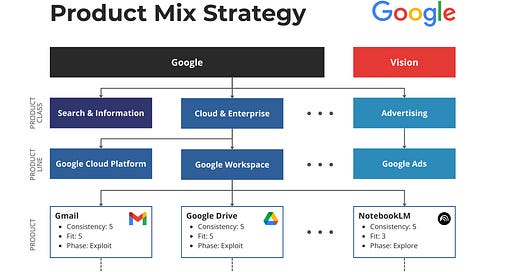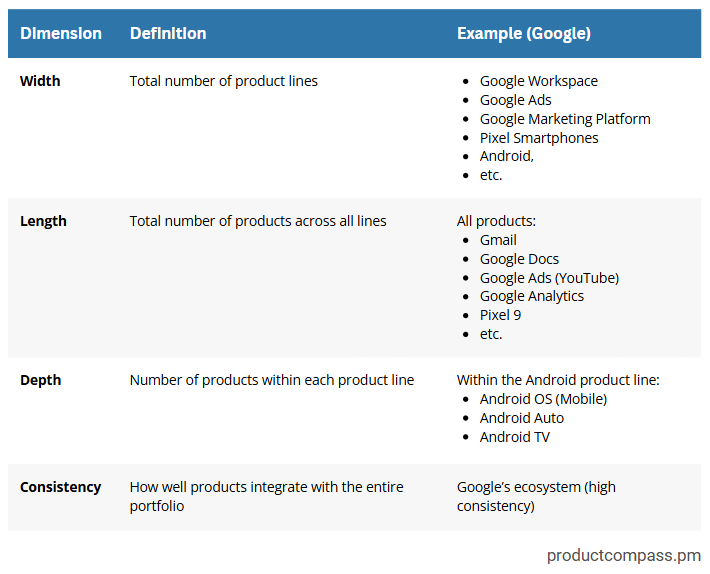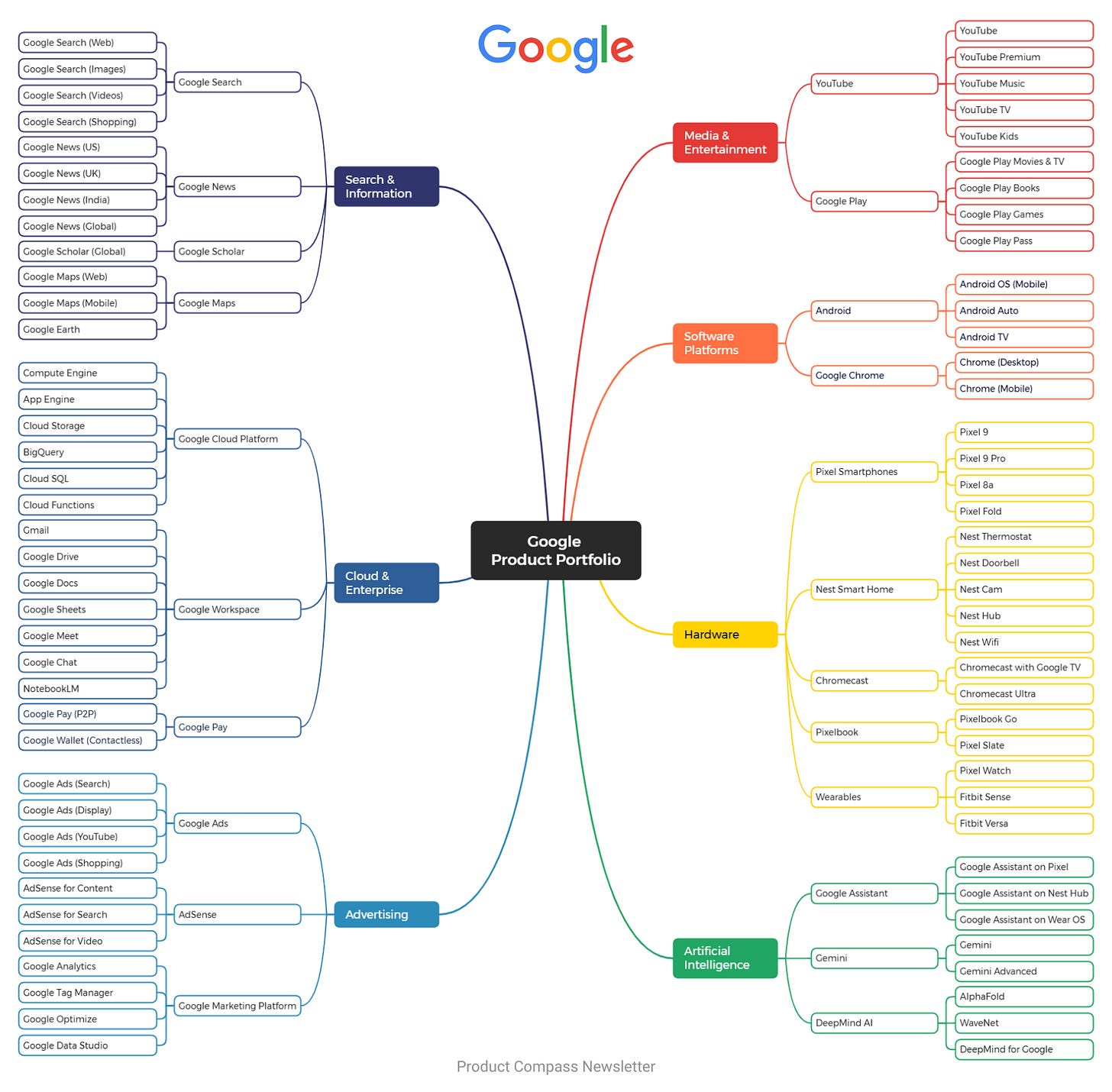Product Mix Strategy: How to Manage & Optimize Your Product Portfolio
How to structure, optimize, and manage your product mix effectively. Google case study and a Product Mix Strategy Template.
Hey, Paweł here. Welcome to the free archived edition of the Product Compass Newsletter!
Every week, I share actionable insights and resources for PMs. Here’s what you might have recently missed:
Consider subscribing and upgrading your account for the full experience:
In October 2024, we discussed an example product strategy for Google Maps.
Today, I’d like to zoom out. After all, Google Maps is not the only Google product.
As explained in the Product Strategy Canvas, strategy is singular, even though it has many levels. For that reason, managing multiple products can be challenging.
A well-structured product mix strategy can make managing multiple products easier.
But most popular sources you can “google” describe a product structure or hierarchy at best, not what we might call “product mix strategy.” I'll explain that in a moment.
This guide will help you organize, refine, and manage your product portfolio effectively.
We discuss:
What Is a Product Mix
Why Product Mix Strategy Matters
The Four Product Mix Dimensions and What’s Missing
Case Study: Google Product Mix Strategy Example
Product Mix Strategy Template
Conclusion
1. What Is a Product Mix
Your product mix is the full set of products and services your company offers.
For example, Google’s product mix includes Search, Gmail, Android, Chrome, Pixel devices, Google Cloud, and YouTube.
Each product addresses unique market segments and user needs while reinforcing the entire product ecosystem.
What is often overlooked is the strategic aspect of the mix - managing and optimizing the entire product portfolio.
2. Why Product Mix Strategy Matters
When managing multiple products, you need a clear product mix strategy to ensure your entire product portfolio works together:
Single vision: Can you glue everything together rather than having products that pull your organization in different directions?
Strategic alignment: How choices across the product portfolio fit together and reinforce each other. This is a classical Michael Porter’s “Fit” test.
Prioritization: Considering limited resources, which products and initiatives should you prioritize? And, more importantly, what are the tradeoffs?
Risk reduction: A balanced mix reduces dependence on a single product.
Innovation: To balance innovation (new products) with exploiting and expanding existing products.
If you ignore this, you risk unclear priorities within the organization, spreading resources too thin, confusing users, or missing growth opportunities.
3. The Four Product Mix Dimensions and What’s Missing
When discussing the product mix strategy, most sources list four dimensions:
Width (also called Breadth): How many product lines (groups of related products) do you have? For example, Google has a “Google Workspace,” a “Pixel Smartphone,” and a “Google Marketing Platform,” among others.
Length: The total number of products across all lines. For example, Google has over 100+ products such as Gmail, Google Docs, NotebookLM, or Pixel 9.
Depth: How many products exist in each product line. For example, the Android product line has Android OS (Mobile), Android Auto, and Android TV.
Consistency: How well do product lines integrate with the entire portfolio.
A consistent mix (like Google’s ecosystem) simplifies operations.
A scattered mix (like Amazon’s e-commerce, AWS, and Prime Video) can be harder to manage but might capture broader markets.
But this classification is far from what we can call a strategy. It has several issues:
It lacks Company Vision, an integral part of every strategy (also see Roger Martin’s article). Vision glues everything together. How can you motivate your employees to wake up every day and go to work?
It misses what I call “Fit.” When managing a portfolio, it’s essential to understand how your products align with user needs (think Product-Market Fit) and business goals.
It completely misses a Product Phase, the concept described, e.g., in The Invincible Company by Alexander Osterwalder and Yves Pigneur, in which authors distinguish between exploration and exploitation. For product portfolio management I suggest three phases:
Explore: These are innovative products in the early stages of development, often requiring significant investment with little or no immediate revenue. They represent the future growth potential we hope will drive the company forward.
Transform: These products are moving from early innovation to broader market acceptance. They are starting to contribute to revenue and show promise for becoming major players.
Exploit: These are mature, well-established products that currently generate significant revenue and profits.
In practice, Product Lines and Options often form a hierarchy. Simplifying this to just two levels is insufficient for many companies like Google, Microsoft, Amazon, or Apple. I suggest considering one additional level, Product Category.
We should also keep in mind that individual product strategies should be considered integral parts of the overall strategy.
4. Case Study: Google Product Mix Strategy Example
Let's take Google as an example.
Google Product Mix
In the graphic below, I included the recommended classification for Google:
Product Class: The broadest category (e.g., Search & Information, Hardware).
Product Line: A subset within a class (e.g., Google Search, Pixel Smartphones).
Product: Specific product (e.g., Google Search Web, Pixel 9).
We could further complicate this with the product variants (e.g. Pixel 9 Pro), but if this classification is good enough for Google, it might work for your product, too.
Google Product Mix Strategy
Now, let’s convert our portfolio into a Google Product Mix Strategy.
🔒 Upgrade your account, if you haven't already, to access a Google case study and Product Mix Strategy template 👇
Keep reading with a 7-day free trial
Subscribe to The Product Compass to keep reading this post and get 7 days of free access to the full post archives.





